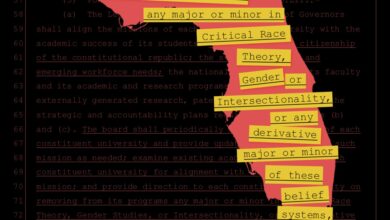A U.S. Program for Migrant Students Is Unusually Successful. Now the Pandemic Threatens It.

[ad_1]
Maria Hernandez started college in the fall of 2020, feeling isolated and insecure.
Confined to her off-campus apartment at Arizona State University, Hernandez struggled through her online classes in kinesthesiology, the medical terminology more foreign than the English she was still mastering. The daughter of migrant farm workers from Mexico, she wasn’t sure she even belonged in college, and she worried about her parents, whose work left them vulnerable to Covid-19.
On weekends, she’d travel from Tempe, where she lived with her cousin, to Yuma to be with her family. But then her father caught the virus, and she couldn’t even visit.
“It was so hard at first, with everything being online,” recalled Hernandez, now a sophomore. “I was alone.”
But there was one thing that helped ease the loneliness she felt: the biweekly Zoom calls with other students from migrant families. It was harder to connect over a screen than in person, Hernandez said, but at least they understood her background and culture, and didn’t make fun of her accent, the way some high-school classmates had.
“When I met them, I was like, ‘Wow, now I feel like I belong here,” she said.
The meetings were part of the College Assistance Migrant Program, or CAMP, a low-profile federal program that helps migrant and seasonal workers and their children navigate the first year of college. CAMP, which turns 50 this year is small — serving roughly 2,000 freshmen on 57 campuses — but mighty, with retention and persistence rates that exceed national averages.
Now, that track record is being threatened by the Covid-19 pandemic, which has caused enrollment losses at colleges nationwide. CAMP directors report increases in the number of students dropping out and say it’s become harder to recruit new students, with some high schools still closed to visitors, and prospective students and their families anxious about attending in-person meetings and events.
A Nexus of Barriers
The pool of potential CAMP participants is fairly large. In 2019-20, the most recent year for which federal data are available, more than 200,000 children and adolescents were receiving migrant education services, including more than 60,000 high schoolers. Some of them are undocumented; others were born in the United States after their parents came to the country for work.
But many migratory children don’t even make it through high school, with dropout rates as high as 50 percent for students who participate in farm work themselves, according to one estimate.
As a group, the children of migrant and seasonal workers (who settle in one place, and travel for work) face many of the same obstacles to college as other low-income, first-generation students, including weak academic preparation, low expectations, and limited financial means. The median family income for farm workers ranged from $25,000 to $29,999 in 2017-18, the most recent year for which we have data, according to a survey by the U.S. Department of Labor.
Migratory students, like all low-income and first-gen students, are apt to attend high schools with overburdened college counselors, and to have parents who are unfamiliar with the college-application process. On average, farm workers have only a ninth-grade education, the Labor Department found.
“Students are very much on their own when it comes to pursuing higher ed,” said Miriam Bocchetti, president of the National High School Equivalency Program/CAMP Association and director of the CAMP program at Central Washington University. “That academic capital and generational knowledge isn’t there.”
Those challenges are compounded by frequent disruptions in students’ schooling. They may move among schools with widely different curricula, making it difficult to keep up. Some skip days — or even weeks — of class to help harvest crops or watch their younger siblings while their parents work.
Cultural expectations can create additional hurdles for migratory students, the vast majority of whom are Latino. Though many of their parents see college as a path to a better life, they are often reluctant to take on loans to pay for it and want their children to stay close to home.

Laura Segall for The Chronicle
This “nexus of barriers,” coupled with the fact that many migratory students are English-language learners, makes such students “the most marginalized group” in higher education, argues Robert Garcia, director of the CAMP program at the University of Colorado at Boulder.
“Any one of those identifiers would say they are less likely to succeed in higher ed, and they embody all of them,” he said.
Those that make it to college often arrive academically underprepared and uncertain they belong, research shows.
But migratory students also come to college with an adaptability and resilience born of a lifetime of change, Garcia said. They’re often highly motivated and determined to succeed in school, eager to escape a life in the field or factory.
“As I child, I saw how hard manual labor is, and I was, like, ‘yeah, I don’t want to be out there,’ said Elber Lopez-Hernandez, a freshman at the State University of New York at Oneonta, who spent several sweaty summers harvesting grapes alongside his parents in western New York, pounding heavy posts into the dry dirt, and plucking snakes and mice from the buckets where the grapes were collected.
His parents pushed higher education, telling Elber and his siblings: “You should go to college, and if not, there’s always the fields waiting for you.”
That thinly veiled warning was all the nudge he needed. “That did it for me,” he said.
An Unequal Impact
The federal effort to help children of migrant and seasonal workers get an education has its roots in Lyndon Johnson’s War on Poverty and the Civil Rights Movement of the 1960s, and was heavily influenced by the 1960 release of a documentary titled Harvest of Shame. The film drew attention to the factors that trapped families in a migrant lifestyle, unable to pursue their dreams of education and social mobility, according to Adrian D. Ramirez, an administrator at California State University at Fresno who wrote his dissertation and an article on the CAMP program.
In 1966, Congress created the Office of Migrant Education to minister to the unique needs of farm workers’ children. The High School Equivalency Program, which helps migrant students earn a GED, was born a year later, and CAMP followed in 1972. The first year, four colleges were given grants to run the program, two in Texas, and one each in Colorado and California. A decade later, there were six, a timeline by Heritage University, a current CAMP grantee, shows.
In the decades since, CAMP has been tested. It was nearly abolished by Presidents Reagan and Clinton, who saw it as duplicative of other federal programs for the poor, particularly the TRIO programs, according to Michelle Kelley, past president of the National HEP/CAMP Association and program director at Boise State University. In fact, CAMP offers more intensive services to smaller cohorts of students, she said.
Though Congress ultimately rejected the cuts, the program saw little growth until 1999, when Clinton, in an apparent change of heart, included funds for 12 additional programs in his Hispanic Education Action Plan, the timeline shows.
Today, more than 50 CAMP programs are scattered across the United States, with a majority concentrated in the West and Southwest. California and Washington have eight each; Texas has nine. The programs offer a mix of advising, tutoring, mentoring, skills workshops, financial-aid stipends, and health and housing assistance to students during their first year of college. Dedicated staff take a case-management approach to supporting students academically, socially, and emotionally, and hold regular social and cultural events.
Despite their disadvantages, students who participate in CAMP persist at rates typically seen only at highly selective institutions. In the 2018 fiscal year, the most recent year for which data is available, 84 percent completed enough credits to finish their freshman year, and 96 percent of completers continued college the following fall.
It’s harder to say what percentage are graduating, since the Education Department doesn’t require programs to track and report that statistic. But a pair of studies conducted at a community college and a four-year institution found that participants in CAMP graduated at rates similar to or higher than the general student population.
Whether that success will continue remains to be seen. Migrant students’ families have been disproportionately affected by the pandemic. When Covid-19 hit, and many people started working remotely, migrant workers had to continue in person, their long-devalued work suddenly deemed “essential” to the economy, Garcia said.
“It’s the first time we’ve given them that dignity, but they were now on the front lines and more likely to contract Covid,” he said.
Migrant students sent home from college at the start of the pandemic were torn between working to help support family members sidelined by Covid and focusing on their online courses, Bocchetti said. Many were unable to concentrate in crowded homes, or lacked the technology or internet access to participate fully. GPAs tanked, and students began “stopping out,” or leaving with plans to return, sometimes in droves, she said.
Some of those stop-outs are back on campus, and caught up with their peers. But finding new students to enroll remains a challenge for many CAMP programs.
Recruiting Challenges
When Covid shut down schools and other public venues in 2020, it also shut down in-person recruiting for the CAMP program. Recruiters could no longer pitch the program at college fairs and school assemblies, and they weren’t being welcomed into family’s homes, either.
Like everything in education, recruiting moved online. But far fewer students showed up for the online events than the in-person ones.
“Nobody wanted to be online,” said Pathy Leiva, director of access and opportunity programs at SUNY Oneonta. At the same time, “sickness and death in their families made it tough for them to leave home,” she said. “Farm and factory workers didn’t have a lot of protections.”
Still, advocates of CAMP have reasons to be optimistic about the future. Public-health experts predict that the pandemic could soon become endemic, and President Biden’s budget for the 2022 fiscal year proposes a $20-million increase for CAMP and the High School Equivalency Program.
Meanwhile, its grantees work hard to overcome the obstacles created by Covid-19. In an effort to reach more students, Leiva got creative, hosting online “Cow Jeopardy,” where students could log on to answer questions about applying for college and win a squishy cow in their mailboxes.
By this fall, recruiting was back to normal in some parts of the country, but heavily restricted in others. Some high schools limited the number of students who could participate in a visit; others remained closed to outsiders. In Pennsylvania, Jenny Hernandez, director of the CAMP program at Millersville University, made her first visit to a school since early 2020 in October. Before Covid, the venue would have been packed with parents, students, and food. This year, 30 people showed up.
“People were afraid,” Hernandez said. “We are having face-to-face with the people who are brave enough to be there.”
For the CAMP program, conversations with parents are critical to recruitment. Sitting down with parents who have never been to college themselves lets recruiters dispel some of the common myths and misconceptions about higher ed, like “you have to come up with the money yourself,” or “everyone drinks or smokes weed,” said Leiva. Recruiters reassure nervous parents that the program will be a second family for them.
But program directors acknowledge that Covid has made it harder for recent cohorts to form familial bonds. Many of last year’s freshmen met mostly, or exclusively, online, and “are missing that sense of community,” said Seline Szkupinski Quiroga, director of Arizona State’s CAMP program.
So this year, Quiroga invited Maria Hernandez and the rest of her cohort to join the freshmen for tamales and a Mariachi concert in a park, to give them a chance to connect in person. She also hired a student worker to check in with last year’s cohort, offering everything from birthday wishes to internship leads.
Hernandez, for her part, says she’s feeling more settled at ASU this year. Asked if she had any advice for other migrant students considering college, she said, “Don’t be afraid.”
“People sometimes can be rude to us, but that doesn’t mean we don’t have the capability,” she said. “When you really want it, you can do it, and there is always someone who is willing to help you.”
[ad_2]
Source link






